Riga
Riga is the financial, creative, and cultural center of Latvia. It is the capital and the largest city in Latvia, it is also the largest city in the Baltic States. The city lies on the Gulf of Riga, at the mouth of Daugava, Riga has an population of approximately 640,000 inhabitants, or 1/3 of the population of Latvia. The city was part of many empires throughout history, each of which has left its mark on the city. It is famous for Art Nouveau and wooden architecture. Riga's historical center is listed as a UNESCO World Heritage site.
Districts
There are many administrative districts in Riga. However, almost all tourist attractions, historic buildings and hotels are contained within the borders of the relatively small and walkable Centra rajons district, which is made up of Vecrīga (the old town) and Centrs (the modern-day business district). However if you have already seen the more famous attractions in the city center, the outer districts do have their own draws too.
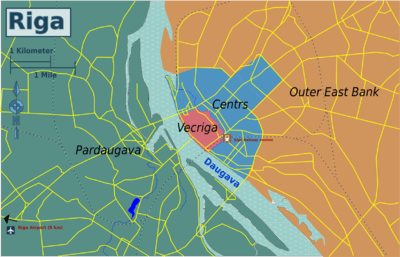
| Vecrīga The old town, entirely listed as a world heritage site, is the primary draw for visitors and many of the city's most prominent sights are here. The car-free streets and alleys are lined with restaurants, bars, shops and hotels. |
| Centrs Centrs, just northeast of the old town, is the commercial centre of Riga, famous for its Art Nouveau architecture, parks and boulevards. It is also a place to go to for nightlife and hotels; the high-rise Hotel Latvija (which doubles as a landmark) with its Skyline bar on the top floor offers both. |
| Outer East Bank Further out on the eastern bank, you have an opportunity to see some more rural attractions including Mezaparks with the city’s zoo. It also includes the district of Maskavas forstate with Jewish heritage and the impressive central market just outside the old town. |
| Pārdaugava The West Bank of Daugava offers nice parks and beaches, 18th- and 19th-century wooden architecture in Agenskalns, the tallest tower in the European Union and includes Riga International Airport. |
Understand
_(7581842090).jpg)
Riga is famous for its world heritage-listed old town (Vecrīga) and city center (Centrs), in which over 800 buildings — a third of all buildings — are of the Art Nouveau (aka Jugendstil) style of architecture and thus Riga is one of the best destinations to see this architectural style. Chiefly built in the first years of the 20th century, many of Riga's Art Nouveau buildings were created by ethnic Latvian architects unlike earlier buildings in the city . The Art Nouveau style involves intricate building facades, with carvings of flowers and mythological creatures, and ornate doorways and windows.
A considerable part of the old town was either destroyed by fire or destroyed by the Germans in World War II but many old buildings were also spared. The old town was a draw of the city during the Soviet times and it received protected status in 1967. The damaged parts, most notably the House of the Blackheads, were restored in the late 1990s, mainly to make Riga more attractive as a tourist destination. Another thing that attracts visitors, especially young adults, is the lively nightlife and discount airlines that offer cheap flights to/from much of Europe.
Riga is bisected by the river Daugava. Old (medieval) town is in the center of the city on the east side of the river. It is surrounded by a ring of ~19th–early 20th-century architecture including the Art Nouveau buildings described above, followed by a mix of private 2-floor house districts (many also pre-World War II) and Soviet-era 5-18 floor apartment districts. Especially near railroad lines, they are interspersed with industrial plants from different eras, including some from the Imperial Russian era.
History
Riga was founded in 1201 by Albert of Bremen as a port city and a base to conquer and convert the native Livonians to Christianity, a goal that was achieved in 1206 after a battle in Turaida during the Northern Crusades. Riga developed as the major trade hub of the area during the peak of the Hanseatic League in the 13th to the 15th centuries and was ruled by the Archbishop of Riga. The Reformation reached Riga in 1522, which ended the Archbishops' power. In 1621, Riga became part of the Kingdom of Sweden, although it maintained a great deal of autonomy. In 1710, an invasion by Peter the Great of Russia ended Swedish rule and cemented Russian influence on the city.
Latvia declared its independence on November 18, 1918. It was annexed by the Soviet Union in 1940. Riga served as the capital of the Latvian Soviet Socialist Republic.
Germans have inhabited the city since its establishment by Albert, and throughout most of its history, Germans were the elite while Latvians remained a lower class. The Germans' position as the elite continued through the Imperial period of Riga, visible in some of the architecture of the city. The Germans were forcibly evicted after the Nazi occupation of 1941-44.
Get in

By plane
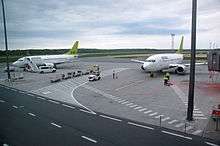
- 🌍 Riga International Airport (Starptautiskā Lidosta Rīga RIX IATA) (is located 10 km southwest of Riga). The airport serves approximately 5 million passengers per year.
Many flights to/from Riga are operated by Air Baltic, Ryanair, and Wizz Air.
There are designated areas in the airport where smoking is allowed.
To travel between the airport to the city:
- Bus 22 and Minibus #222 run between the airport and the old town, with a stop near the central bus and railway stations and Minibus #241 runs between the airport and Esplanāde, at the north end of the old town. These buses operate as any other public transport in Riga; see Riga#Get_around for more information on riding the buses. The journey to the old town takes 30-40 minutes. The last buses leave the airport at 00:05, or 23:40 on Saturday, Sunday, and holidays. The bus stop is located opposite the entrance of the terminal. There is a ticket machine at the bus stop or tickets can be bought at the Narvessen shop on the departure level in the airport. Day and multi-day passes are not valid on the minibuses.
- The ride to the center by taxi takes 15 minutes. Taxis can charge whatever they want, as long as the rates are displayed on the car and the maximum rate to the city center is €25. Some taxis will illegally try to charge even more.
- The best way to hire a taxi is to use the Taxify mobile app, which allows you to see the rates being charged, time to pickup, enter the destination, and pay with the credit card that is linked to your account.
- Baltic Taxi runs taxi service from the airport to the centre for a fixed price of €15 if booked online or via metered rates if paid to the driver. Service to the old town takes 15 minutes.
- Red Cab Taxi offers metered taxi services from the airport. A journey to the city center costs approximately €12 and the ride takes 15 minutes, depending on the traffic. Wheelchair accessible mini-vans are available but must be pre-ordered.
- Personal Minibus offers airport transfer for groups. The price of €8 per person (6 person minimum) also includes guide to meet group with a greeting sign.
By bus
There are international bus connections to anywhere in Europe, including frequent service to Tallinn and Tartu in Estonia, and Vilnius and Kaunas in Lithuania. 🌍 Riga's main bus station is located just outside the old town.
- Ecolines - operates service between Riga and most major cities in Europe.
- Eurolines Lux Express - Comfortable & free coffee. Buses to Tallinn or Vilnius take about 4 hours and cost €15-28, but with discounts to €7-9 if you book early. Buses to Saint Petersburg cost €35.
- Flybus - Service between Riga and the airports of Kaunas and Vilnius.
- Traveller Tours - Minibus sightseeing tours from Tallinn to Riga, stopping off at different sights along the way. €55
By ferry
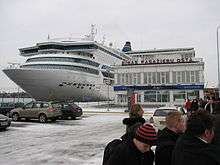
Tallink Silja Line operates a ferry service every two days between Stockholm and Riga, with a landing at 🌍 Rīgas Pasažieru termināls near the old town. The journey with M/S Isabelle takes 17 hours. Tickets for a day in Riga cruise for one person (6½ hours on shore in Riga) begin at €37. Regular round trips begin at €117. M/S Romantika provides a daily ferry service between Stockholm and Riga.
By train
The main railway station, 🌍 Rīga Pasažieru, is south of Centrs and east of the old town and with good public transport connections to all parts of Riga. AS Pasazieru vilciens (English: "Passenger Trains" company) operates service to many cities in Latvia, including the suburbs of Riga, and to a few cities in Russia, Belarus, and Estonia. You can book tickets online via the Latvian Railways site up to 45 days in advance, but tickets must be collected from a station in Latvia, with the exception of tickets to Moscow and Saint Petersburg which can be issued as e-tickets in both directions.
Trains depart for the 16-hour overnight journey to Moscow daily (except New Year's Eve) at 16:45 with an additional train departing at 18:10 from May to September. The overnight trip costs €36-205 depending on service level. Additionally, Ukrzaliznytsia runs a night train from Kiev (19 hours) via Minsk (9 h) once a week.
Trains depart for the 15-hour overnight journey to Saint Petersburg daily (except New Year's Eve) at 18:35. The overnight trip costs €30-175 depending on service level.
A few trains operate between Riga and Valga, Estonia. From Valga, connections can be made to other cities in Estonia including Tallinn. However, it is much easier to travel to Estonia by bus.
Vilnius is much easier to reach by bus than by train. However, on weekends there are connections from Vilnius to Riga with a change of trains in Daugavpils. Trains depart in Vilnius at 05:52 and 11:45 with arrival in Riga at 16:35 and 21:11 respectively. The stopover in Daugavpils is 3-4 hours. There is another train leaving Vilnius early in the morning that takes only 4.5 hours, but it runs only once per week. The timetable can found here.
By car
Riga has good road connections with Estonia, Lithuania, Russia, and Belarus. Riga is on the Via Baltica and ~300 km from Tallinn and Vilnius. In the city center, you have to pay a fee for public parking which varies depending from distance to center.
Get around
By foot
Vecrīga is comprised mainly of rounded cobblestone streets that may be hard to walk on if you are not wearing proper shoes. Outside of Vecrīga, most streets are paved with asphalt, although some smaller streets may be unpaved. Sidewalks are predominantly concrete everywhere. Vecrīga is best explored on foot. Due to the neglected drainage system, the streets may be flooded during heavy downpours.
By public transport
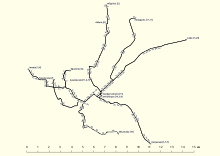
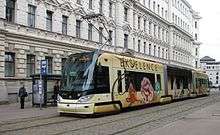
The city-owned Rigas Satiksme operates the trams (street-cars), buses, minibuses, and trolleybuses. They all use the same e-ticket system called e-talons. A single fare covers a ride on any one route independent of the distance - i.e. a transfer requires payment of two fares. However, if you enter a vehicle with the same route and in the same direction within one hour, your ticket is still valid and will not be charged again. The Rigas Satiksme website provides a great interface for planning a trip within Riga. Also, for routes, timetables and live (bus and tram) traffic see this mobile friendly page.
Single fares are €2 during at all times if paid on board to the driver (cash only, exact change preferred) or €1.15 for bus/tram/trolleybus/minibus trips if an e-talon card is purchased in advance from a ticket office, vending machine, press kiosk, Narvesen shop, or other location listed on the Rigas Satiksme website. These electronic tickets are for one time charge only, without deposit. You pay the number of rides that you want on them (even if it is just one ride), and discard after using up all rides. A 5-ride ticket costs €5.75, 10 rides are €10.90, and 20 rides are €20.70. Also available are tickets for 2 trips for 2 people costing €4.60 and 2 trips for 3 people costing €6.90. Unlimited ride 24-hour cards cost €5.00, 3-calendar-day cards cost €10, and 5-calendar-day cards cost €15. The cards all are activated by using the yellow device in the vehicles. You must activate all cards every time that you enter a vehicle. The Riga Card allows the holder to travel free on public transportation.
Tram lines are numbered 1–11; bus lines are numbered 1-55; trolley bus lines are numbered 1–27. Minibus lines have numbers 200-280. Night buses are numbered N1-N10. While the numbers are similar, the routes are completely different - i.e. bus #2 is totally different from trolleybus #2. Tram numbers on stops are identified by "Tr", buses (not trolleybuses) by "A". Stops are marked by a blue rectangular sign with a stylized white image of the vehicle and lists the numbers that stop there. Timetables and stops of the route are also usually posted at stops and are fairly accurate. Bus routes are marked "A", but tram and trolley bus routes are marked "T" on timetables, except tram timetables should have red background for the "T" letter and trolley bus—yellow. With the exception of minibuses, the vehicles include an LCD screen with next stop information.
Trams are generally the fastest public transportation apart from trains. Although they are on street level and the rails are not physically separated from the rest of the traffic, in all but the busiest rush hours they have the right of way. Minibuses are smaller and thus more maneuverable than buses and trolley buses, making them the second-fastest mode of transport.
By bicycle
SIXT Latvia operates self-service bicycle rentals at bicycle stands across the city. The service is available to both residents and guests of Riga. You must have a mobile phone to register, but registration is free. The bikes have 3 speeds and lights, but no helmets. The advertised price on the website is €0.90 per 30 minutes, with a maximum of €9 per day. However, the effective amount charged seems to be €0.99 (Oct 2017) per half hour (the first minute of a subsequent half hour counts as a full 30 minutes).
Alternatively, ask your hotel if they provide bicycle rental.
Downtown Rīga has a lot of cobblestone streets, so be prepared for a bumpy ride. Bike lanes and paths exist but are not always marked clearly. On main roads, you may occasionally end up finding yourself on the wrong side of a guardrail.
By taxi
The best way to hire a taxi is to use the Taxify mobile app, which allows you to see the rates being charged, time to pickup, enter the destination, and pay with the credit card that is linked to your account.
If you hail a random taxi on the street, be aware that the taxi may not follow the most direct route and may use a meter rate that will significantly overcharge you.
By car
It is not advisable to get around Riga by car unless you need to move things around. The street infrastructure has the same capacity as when it was initially planned a hundred years ago or more, and traffic congestions are the norm during working hours, which is most of the day. Traffic can be extremely slow, especially on the bridges.
It can be difficult to find a parking spot in Riga during working hours. In the very centre and the old town of Riga and on the Ķīpsala island parking services require a fee in certain streets. In the old town this can be up to €8/hour.
There are several car rental offices at the Riga airport as well as in other parts of the town. You can even rent a cheap Soviet-style car.
Drunk driving
Driving drunk is considered a serious law violation. Besides high fines and a seized driving license you can easily end up serving 10-15 days in an administrative arrest. Maximum alcohol contents in the blood must not exceed 0.05 g/dL. There are plenty of police patrols and it is very common to be stopped for an alcohol test.
By boat
Boat service is available from May to September from/to Jūrmala. The boats stop in Riga stop near the Stone Bridge (Akmens Tilts), which is right next to the House of Blackheads/Riga Tourist Information Centre, in the old town. The trip costs €15-20 and takes 2½ hours -- it is much slower and more expensive than train service.
See
- Individual listings can be found in Riga's district articles
For tourists, the most interesting districts are Vecrīga (the UNESCO-listed Old Town) and the area around the nearby Freedom Monument, which do double duty as the setting of Riga's foremost historic sites and the center of its burgeoning nightlife. In Vecrīga, the two main clusters of historic sites lie just a few blocks from each other: Town Hall Square, which contains the striking 13th-century House of Blackheads, the Town Hall (built in 2003 as a down-to-the-last-detail copy of the 17th-century original), and Riga Cathedral and the square surrounding it. There you'll also find important museums such as the National History Museum of Latvia (located in Riga Castle) and the Museum of the Occupation of Latvia (closed for refurbishment until late 2018, with the exhibition moved to temporary premises), as well as remnants of the Medieval-era city fortifications popping up here and there.
Further out from Vecrīga is Riga's modern-day downtown (Centrs). Aside from the aforementioned Freedom Monument, architecture buffs flock here to admire the beautifully preserved Art Nouveau row houses on Alberta iela and other nearby streets — one of the densest clusters of architecture of that style in the world — as well as still more museums, such as Latvia's National Museum of Art.
However, there are places worth visiting outside the city center as well. Some other old and well-preserved urban districts that are relatively unvisited by tourists include Agenskalns and Tornakalns, just over the Stone bridge. Further out, the residential areas on the periphery of town are largely made up of gray apartment blocks built in the typically Soviet style. These areas are nearly identical to those all over Eastern Europe. However, they do give an idea of how the vast majority of the people in Riga live and of the history of the area.
The Riga Card, which costs €16-26, has discounts for museums and some tourist attractions.
Organized tours
The tourist office, located inside the House of Blackheads, offers guided tours and free pamphlets, complete with detailed descriptions of many buildings, for independent walks. These walks cover the old town, the nearby city center sights, and the Art Nouveau district. It's easy to do each of these in around an hour, or linger and read every detail in the booklet. In the absence of any signs or plaques around the city, the booklet gives you an insight to what you are seeing.
Many private companies offer organized tours of Riga. Options include bike tours, Segway tours, pub crawls, hop-on-hop-off bus tours, walking tours, free tours, and tours focused on a certain aspect of Riga - away from the touristy old town.
Do
- Individual listings can be found in Riga's district articles
If you're interested in classical culture, head to the National Opera in the Old Town to enjoy opera or ballet or to the Koncertzāle Ave Sol a little further north. The city has several pleasant parks, notably around the city canal and further north into Centrs. Another interesting park is Mežaparks in the north of the city with beautiful old villas and Riga's zoo.
It's also possible to do a boat ride on the canal, making a tour around the old town on the Daugava river. Start point is near the Freedom Monument.
Also, check out the nearby sights of the Riga region, some of which allow for a good day trip from Riga due to the frequent and comprehensive travel options of the region.
Adrenaline sports
Riga and its surroundings are popular destinations for adrenaline sports, which can be booked online, from most hostels and hotels, or from any local travel agent. The activities generally include transfers to/from your accommodation and all necessary supplies. Popular activities include bobsledding, AK-47 shooting (€40), bungee jumping from a cable car, scenic flights, canoeing, kayaking, go-karting, golfing, paintball, drift biking, husky dog sledding (€40), indoor skydiving (€60), and driving a 4x4 off-road.
Festivals and events
- Easter (Lieldienas). Egg fights!
- Count of May (Maija Grāfs), Spīķeru laukums. Medieval festival. Takes place annually in mid-May.
- Latviabeerfest, Vērmanes garden, ☎ +371 27 726 200, e-mail: info@latviabeerfest.lv. Takes place annually at the end of May. The largest international beer festival in the Baltics.
- Jāņi. On June 24, Latvians celebrate the summer solstice with the midsummer festival called Jāņi. Before the celebration, flea markets are held in many places.
- Latvian Song and Dance Festival (Latvian Vispārējie latviešu Dziesmu un Deju svētki), Vērmanes garden, ☎ +371 28611731, e-mail: presescentrs@dziesmusvetki.lv. An annual song and dance festival in July, with an even larger festival every 5 years. One of the key cultural events in Latvia, which started in 1873 as a singing festival.
- Rīga City Day (Rīgas svētki). Takes place in the middle of August (2017: on Aug 18-20). Traditional weekend of celebrating a city. Many cultural events take place all around the city, including Street Music Day. Booklet
Jewish legacy
Riga had a significant Jewish population during the Russian Empire period and therefore has a significant Jewish legacy.
- Great Choral Synagogue ruins
- Jews in Latvia museum
- Riga Ghetto and Latvian Holocaust museum
Buy
|
Russian Language School of Baltic International Academy Scam
|
- Individual listings can be found in Riga's district articles
Buy items like amber and wool mittens and socks in the central market or throughout Vecrīga in little stands. You might haggle and get good prices for souvenirs.
During the Christmas season there is a small Christmas market in the main square of old town which offers lots of festive fare and hot wine.
Like in other cities around the world, you can find shopping malls in the suburbs along most major thoroughfares. While not attractions in themselves, they may come in handy especially if you get around by car; you can buy things you need on your trip, some Latvian specialties to bring home or have a quick meal there.
Eat
- Individual listings can be found in Riga's district articles

Riga, as the most vibrant and cosmopolitan city of the Baltics, offers countless opportunities to sample both local cuisine and international favorites. Latvian food can be hearty, using a lot of potato, cabbage, beef, pork and fish. A diversity of foreign cuisines is also available — sushi restaurants in particular are in vogue.
The most central districts Vecriga and Centrs are the places to go for the widest selection of restaurants, though there are certainly also places to eat elsewhere in the city. There are a couple of local restaurant chains that have eateries in many different parts of Riga:
- Čili Pica, Several locations (One near the Freedom Monument, another on the ground floor of the Stockmann mall near central station). Cheap but good pizza.
- Fontaine Delisnack, 3 locations including Teātra iela in the Vecrīga, ☎ +371 67 250 250, e-mail: info@fontaineriga.lv. A 24-hour diner with an extensive menu, this restaurant chain is popular at all hours of the day and night. Try the large CB Burger for €5! Free delivery for orders over €25, otherwise there is a €3 delivery fee.
- Lido. A network of 8 restaurants offering decent hearty Latvian food, including desserts, at good prices. The restaurants are either cafeteria-style or feature English menus.
Drink
|
Bar scams in Latvia Latvia is home to a number of fraud/extortion scams in bars, run by the local mobs. A common scam, which targets men, begins by having someone you meet randomly coax you into a bar. Upon buying a drink, you will be presented with a bill for as much as €100. If you can't pay with cash, the bar will take credit cards - or you might be forced to withdraw money from their handy ATM. If you ask, you will even be presented with a menu and the €100 price listed. If you refuse to pay, the exit door will most likely be blocked by a large bouncer. The trick to avoiding this scam is not to enter a bar recommended to you by someone on the street. Below is a list of bars/clubs in Riga known to conduct this scam. Many are strip bars or locations of prostitution rings. These shady establishments change their names often to escape lists like these and continue extorting unwitting travelers, so use your judgment when entering a bar, or check reviews of the establishment online before entering.
|
- Individual listings can be found in Riga's district articles
Cafes
Black coffee in Latvia is traditionally served unfiltered and quite strong in small cups. If you are used to filtered coffee, you may want to have a "white coffee" (with either milk, whipped milk or cream), or you want to have a glass of water on the side. Coffee "to go" has become increasingly popular, and many of the coffee chains offer coffee served in paper cups with lids.
In addition to the independent coffee shops listed in district articles, several international coffee chains such as Double Coffee, Coffee Inn, and Costa Coffee, have locations in Riga.
Bars
Riga is a major nightlife destination for tourists and bars here are often open later than those in other European cities. On average, bars in Vecrīga will charge €2-3 per beer and bars outside of Vecrīga will charge €1.50-2 per beer. A specialty liquor is Riga Balsam, which is an acquired taste.
Clubs
Riga is known for a sparkling nightlife. There is a difference in style between 'Russian' clubs and 'Latvian' clubs.
Sleep
- Individual listings can be found in Riga's district articles
Hotels and hostels in general offer free WiFi and many have computer terminals. Almost all accept credit cards.
Unsurprisingly the largest concentration of hotels are in and around Vecrīga. For budget accommodation, head to the eastern half of the old town and the surroundings of the railway station. Upscale hotels are to be found in the core of Vecrīga and around the Esplanade Park in Centrs.
Stay safe
As with neighboring Vilnius and Tallinn, Riga is generally safe if you know how to take the basic precautions. Riga's old town is extremely safe at all times, as are the city's major thoroughfares. On the other hand, certain areas in the city's western parts have had their share of crime since the fall of the USSR.
Many Latvians will tell you that any Russian-speaking neighborhood is rife with crime and violence. While this may be blown out of proportion due to historical tensions, many parts of Riga with significant Russian populations do need to be avoided after dark.
Alcohol consumption in Riga is high and bar fights are relatively common. It is wise to be level-headed and not escalate a situation. See the info box in the Riga#Drink section regarding common bar scams in Riga.
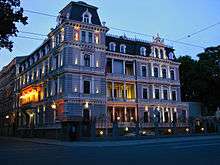
Cope
Embassies
Many details can also be found here: https://www.embassypages.com/latvia
















Go next
The Baltic states are compact and virtually all of the region is within 300 km of Riga, at least as the crow flies. All of Latvia and a large part of what Estonia and Lithuania has to offer is doable as a daytrip if you have a car. However, larger cities listed below do have several days' worth of attractions.
Latvia

- Sigulda – A town in central Latvia with many interesting castles and historic points of interest. Probably, the most popular destination outside of Riga for foreign tourists, also due to its closeness.
- Jūrmala – A popular holiday and sea resort town with wooden houses just west of Riga, which claims to have the longest beach in Northern Europe.
- Salaspils – a former German concentration camp site 15 km southeast of Riga.
- Ligatne – A village fairly well known for its nature trails, with a great natural park with wildlife animals and "fairy tale" forests with characters from famous Latvian fairy tales. Nearby, also an old Soviet bunker complex can be visited, which was built in case of a nuclear war.
- Cēsis – One of the country's oldest towns. It has an impressive castle complex of Livonian Order origin, a charming city centre with some cobblestoned streets, and historic wooden buildings.
- Liepāja – Named "the city of wind", and the southwestern most city of Latvia. Famous for its sandy beach, numerous music events, and the largest organ in the world. It features modern architecture and a long history along with the formerly secret Soviet military neighbourhood of Karosta (literally: War Port).
- Valka – A unique town on the Estonian border, which runs through the town centre, creating Valga on the other side. It is close to regaining the status of an important cultural centre.
Estonia
- Tartu – Museum-rich and hanseatic city on the banks of the Emajõgi River. Also, Estonia's second-largest and oldest city, intellectual hub famous for its universities, and a lively student city. Accessible from Riga by direct bus.
- Tallinn – The capital, and financial and cosmopolitan centre of Estonia, with a medieval Old Town. Beautiful and expensive. A 5-hour bus trip from Riga.
- Pärnu – Estonia's 4th largest city and the summer capital of Estonia, popular for its balneo-therapy complexes and spa centres, surrounded by numerous beaches, little more than halfway to Tallinn.
Sweden
- Stockholm - accessible via direct ferry from Riga; 17-hour journey
| Routes through Riga |
| Ventspils ← | W |
→ Rēzekne → Moscow |
| Tallinn ← Saulkrasti ← | N |
→ Bauska → Kaunas |
| Kaliningrad ← Jelgava ← | SW |
→ Sigulda → Pskov |